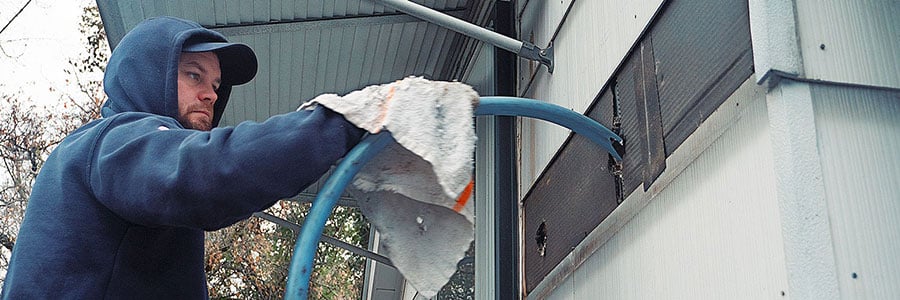Can Foam Insulation Be Installed in Cold Weather?
spray foam insulation | RetroFoam insulation | foam university


If you’re ready to have foam insulation installed in your home, pole barn, or commercial building, winter weather might have you wondering whether snow or freezing temperatures will affect your installation schedule.
The short answer? It depends on the type of foam insulation being installed.
Let’s dive into the details and clear up the confusion about foam insulation installation in cold weather.
Foam Insulation Installers and Winter Weather
Foam insulation is a versatile product that works in a variety of climates, but Mother Nature can still influence the installation process.
Here’s a breakdown of how different types of foam insulation handle cold weather.
RetroFoam Insulation
RetroFoam is a fantastic option for existing walls in your home.
One of its advantages is that snow or cold temperatures typically won’t interfere with installation. Unless there’s a severe weather event – like a state of emergency or a blizzard – most foam insulation installers can move forward as planned.
Open Cell Spray Foam Insulation
Open cell spray foam is another reliable option for cold-weather installations.
Whether you’re insulating your attic, crawl space, or metal building like a pole barn, open cell foam’s high expansion rate ensures that it performs well even when temperatures drop. This means you generally won’t need to reschedule your installation due to cold weather.
Closed Cell Spray Foam Insulation
This is where things get tricky.
Closed cell spray foam behaves differently in cold conditions. Its low expansion rate makes it more susceptible to issues when temperatures dip below 35 degrees Fahrenheit.
At these lower temperatures, installers face two main challenges.
- Reduced Yield: Closed cell foam doesn’t expand much to begin with, so any loss in yield can significantly affect the installation.
- Increased Cost: To create an effective air seal in colder conditions, contractors may need to use more product, which can drive up costs.
In most cases, foam insulation installers will recommend rescheduling closed cell spray foam installations if temperatures are too low. However, if rescheduling isn’t an option, it can still be installed – just be prepared for higher material costs.
Can Spray Foam Insulation Be Applied in Cold Weather?
Yes, but with some caveats, depending on the type of foam.
Here is a quick recap.
- RetroFoam: Installation isn’t impacted by cold weather unless severe conditions make travel unsafe for the crew.
- Open Cell Spray Foam: Performs well even in colder temperatures, thanks to its high expansion rate.
- Closed Cell Spray Foam: Installation is more challenging below 35 degrees, often requiring rescheduling or additional material to ensure a proper air seal.
What Happens if You Need to Reschedule?
Rescheduling due to cold weather might feel inconvenient, but it ensures that you get the best results.
Installing closed cell spray foam in unfavorable conditions can compromise its performance and lead to higher costs. If your project involves closed cell foam and you’re on a tight timeline, communicate with your contractor to explore all options.
Tips for Homeowners Scheduling Winter Foam Insulation Installation
- Talk to Your Contractor: Always ask your foam insulation contractor how they handle winter weather and what steps they take to ensure a successful installation.
- Plan for Delays: If you opt for closed cell spray foam, understand that extreme cold temperatures could cause delays.
- Explore Alternatives: For projects requiring immediate attention, open cell spray foam or RetroFoam might be better options for winter installations.
Ready to Learn More About Foam Insulation for Your Project?
If you’re curious about how to install foam insulation or have questions about the best product for your project, check out the Learning Center on our website.
You’ll find tons of educational videos and articles to guide you through the process.
Related Articles
Installing Spray Foam Insulation in Metal Buildings When It’s Cold
Home Insulation for Extreme Climates – Best Practices for Hot and Cold Environments
What is the Difference Between RetroFoam Injection Foam and Spray Foam Insulation?
About Amanda Emery
Amanda previously has worked as a breaking news and crime reporter, TV news producer, and editor. As a journalist, she has won several awards from The Society of Professional Journalists - Detroit Chapter and the Michigan Press Association. Amanda uses her experience as a journalist to write content that will help educate homeowners on foam insulation benefits. When Amanda isn’t writing, she’s spending time with her husband Chris, daughter Lilith-Maeve, and rescued huskies Danger and Wendigo. She also loves knitting, making art, and cooking.



